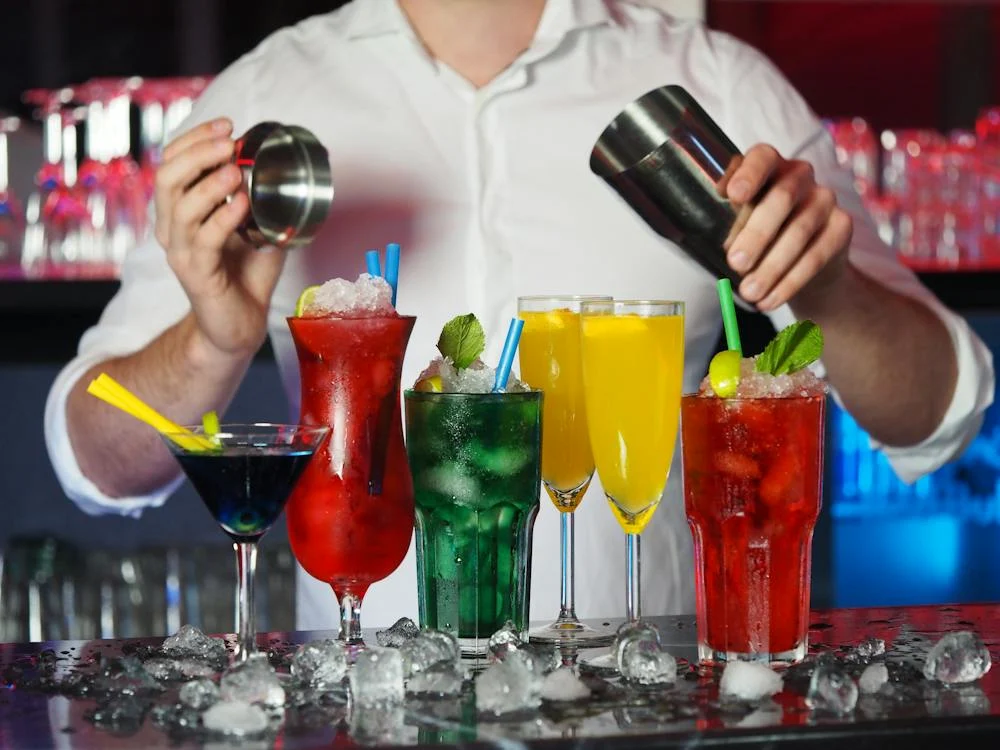It’s Friday night and you’ve been waiting all week to hit the bar and drink your stress away. You get there and order your favorite drink. Finally, you can take that long-awaited sip, but wait! Something’s not right. The bartender messed up your drink, but how?
Bartending, as an art form, requires practice and learning from mistakes for rookies. Every bartender begins somewhere, yet there are avoidable common mistakes. Avoiding these errors enables bartenders to concentrate on crafting excellent drinks while minimizing disruptions and the displeasure of frustrated managers.
So regardless of which side of the bar you stand on, here are a few things you should consider to keep your drinks at their best. Let’s get right to it.
1. Allowing Disorder to Prevail
It’s easy to get overwhelmed at the bar. Bartending requires mastering the art of multitasking, yet it should not serve as an excuse for neglecting cleanliness.
Avoiding the onset of chaos necessitates implementing an organized system. Tools and bottles should be conveniently accessible, and a clear sequence should be followed for preparing drinks and tidying up before attending to the next customer. This way, everything stays cool and systematic.
2. Glassware
There are three things to be careful with in handling glassware at the bar.
- Use of Ice Scoop – although dipping a glass directly into the ice bin may appear to be a convenient shortcut, any experienced bartender can attest to the potential disasters this may cause. During a busy evening, it’s very unlikely for a bartender to spot a subtle crack in a glass. When this compromised glass comes into contact with ice, even a small fracture can quickly break it. Now imagine the time it would take to melt the ice and clean up the shards during peak hours. Just use the scoop.
- Match glassware to cocktail – each cocktail has its perfect glass to match. Coupes effectively contain your Martini, preventing any spills. Hurricane glasses generously accommodate the slushy, sugary bomb. Highballs provide ample room for a generous serving of your fizzy, refreshing Gin & Tonic. Match them up.
- Handling glassware correctly – bartending is a food service, too, and requires you to pay attention to responsible sanitary practices. Rookie bartenders often make the error of handling glassware as if they were simply tidying up at home. It is crucial to educate them about the importance of never touching the inside of a glass, even if it is dirty. Managers should instill the habit of using a tray or carrying glasses from the bottom to prevent any contamination. Safety first.
3. Pouring it Wrong
Mastering the skill of pouring an exact two ounces requires substantial practice and muscle memory. However, there is no shame in needing a measuring jigger to ensure precision. Bartending can be a lot like baking, you need to get the ingredients just right. Embracing this technique prevents overly generous cocktails that negatively impact the bar’s profitability, while also safeguarding the drink’s integrity by maintaining the ideal balance of ingredients.
The perfect pour of beer demands its own technique. Inexperienced and rushed bartenders are prone to overlooking the crucial intricacies involved in drawing a cold pint with an ideal foam head. To get this, the empty glass should be tilted at a 45-degree angle, with the spout directed towards the center. As the glass approaches being filled, it can then be adjusted to a 90-degree angle and completed with a final top-off, resulting in the ideal pint.
4. Shaking vs. Stirring
Errors are inevitable, but with careful planning and a little tech, the journey from being a noob bartender to legendary drink slinger can be made considerably smoother. The key lies in maintaining organization, staying well-informed, and relying on a well-defined operating system.
It’s simple. Unless a drink adds juice or eggs as ingredients, shaking is unnecessary. Likewise, stirring when shaking is called for will fail to achieve the desired frothy and delicate texture of the beverage.
Also, give each drink time, ensuring that it receives the required 30-second shake for optimal aeration and dilution.
5. Get Some Fresh Juice
Prepackaged citrus juice can adversely impact your cocktail with their artificially tart taste. To benefit your body and please your palate, it is recommended to go for real fruit and squeeze fresh juice instead. Don’t limit yourself to lemons and limes; incorporating fresh pineapple, grapefruit, and orange juices can significantly enhance the flavor of any fruity cocktail. Stocking your bar with vibrant, fresh produce will impress your guests and that’s definitely a plus.
6. Chilling Drinks
Strain your cocktail. If you believe that the ice in your mixing tin is indistinguishable from a fresh handful directly from the freezer, you are mistaken. As ice jostles inside the shaker, it undergoes considerable chip and break, resulting in pieces that melt much faster compared to fresh cubes. However, this doesn’t mean that ice never goes directly from the shaker to the glass, you only do it when the recipe requires.
Chill the glass. Enhancing the drinking experience, a chilled glass adds a touch of frostiness. It is also great if you want to slightly cool a neat spirit without diluting it with ice. Simply place your intended tumbler in the freezer before you start mixing your drink, and by the time you’re ready to strain, it will be pleasantly chilled.
Oh, and improve your ice. Source it better and stock it well.
7. Freezing Old Spirits
It is not advisable to toss just any spirit into your freezer. The cold temperature can stifle the volatile compounds found in spirits like whisky, which play a significant role in their taste and aroma. Consequently, the freezer becomes an unfavorable environment that dampens the flavor. However, vodka, known for its purity and cleanliness, can be safely stored in the deep freeze. In fact, the cold can contribute to a thicker texture, resulting in a delightfully rich sip. But for any other spirits, it is best to keep them securely on your bar cart.
Conclusion
A lot of things can go wrong when tending to the bar and it’s usually the little things that leave a big impression. Fortunately, a lot can be done to improve on the experience, too. Never hesitate to step up your your game and try out new ideas. Cheers!

